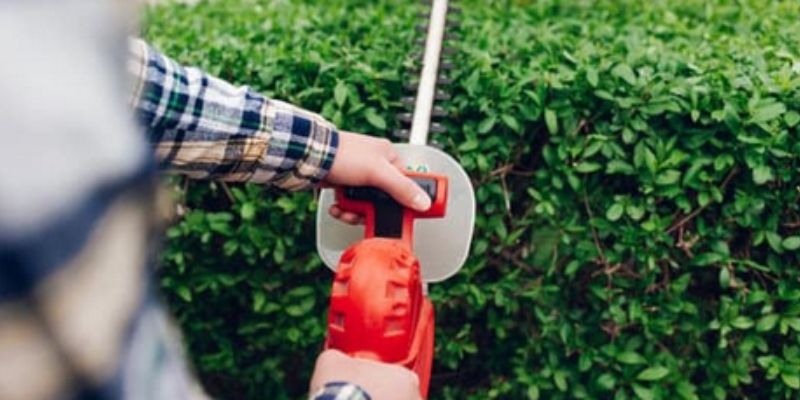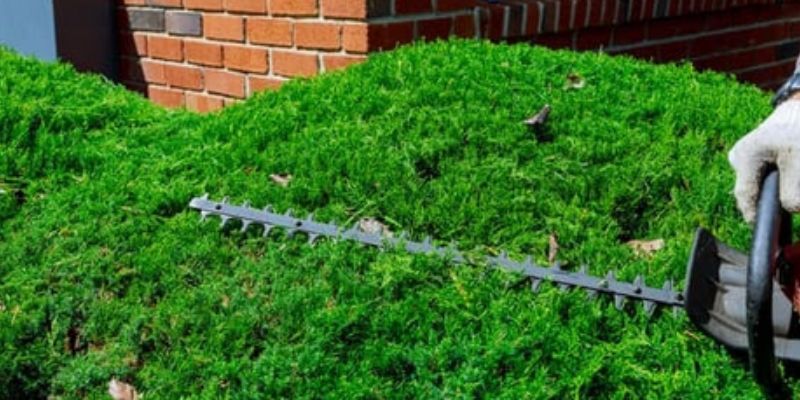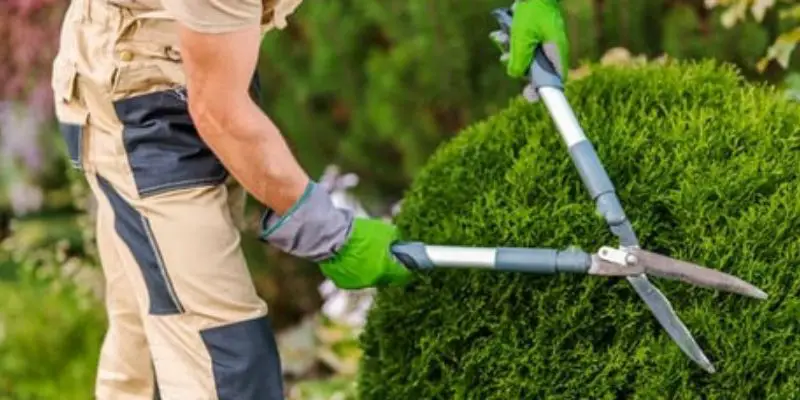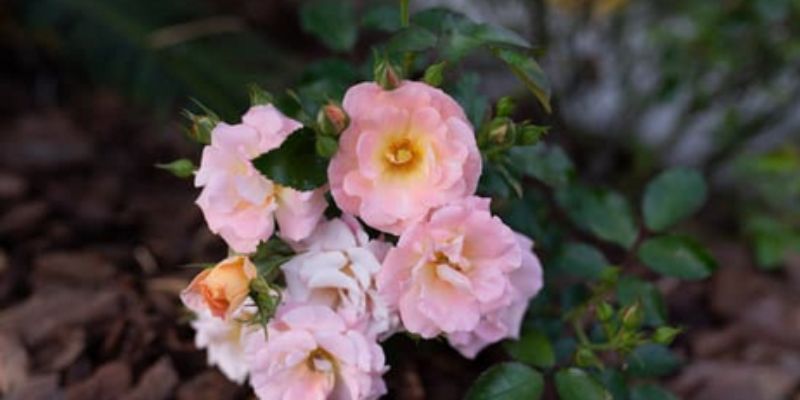Overgrown bushes crowding your landscape quickly go from fabulous foliage to a nuisance. Learning the proper techniques on how to cut bushes down transforms them from unruly to orderly once again.
Cutting bushes down to size or removing them entirely opens up garden space for new plantings. Plus neatly trimmed shrubs make features like architectural elements, garden sculptures, or decorative walkways visible to enjoy.
This comprehensive guide covers all you need to know about how to cut bushes down safely and correctly. You’ll learn proper tools, timing, trimming techniques, removal methods, and cleanup for managing overgrown bushes. Soon you’ll tackle overgrown landscaping with confidence!
When to Trim Bushes
Timing is an important part of learning how to properly cut bushes down. Try to avoid pruning shrubs at the wrong time of year which interferes with flower production or next season’s shoot growth.
Before grabbing those pruners, it’s key to know what kinds of bushes you have and when it’s best to trim them. This info ensures your bushes stay healthy and achieve the look you want.
- Evergreens: These bushes keep foliage year-round, making them popular for constant greenery. Think boxwood, holly, yew. Trim evergreens in late winter/early spring, just before new growth sprouts.
- Deciduous: As named, these bushes lose leaves annually. See: forsythia, lilac, viburnums. For deciduous bushes, trim in late winter/early spring before buds pop.
- Flowering: Azaleas, rhododendrons, hydrangeas – timing is everything! Prune right after blooming so you don’t lose next year’s flower buds.
Trimming bushes when dormant causes less stress and reduces disease vulnerability from open wounds. Plus winter removal of distracting foliage draws attention to the elegant branch structure.
Bushes to Trim:
- Overgrown shape
- Crossing/rubbing branches
- Dead or damaged branches
- Bushes encroaching walkways/structures
Knowing the different bush types and best trimming times means you can maintain beautiful, healthy bushes.
Tools for Cutting Bushes Down
In addition to timing, having the proper tools makes learning how to cut bushes down easier. Different shrub cutting tools serve distinct purposes depending on factors like branch thickness and height.
Here are the best tools for cutting back overgrown bushes:
- Bypass hand pruners: Pruners cut stems up to half inch diameter with a clean snip. Look for quality blades that stay sharp through prolonged use.
- Hedge shears: Long blades shear through dense foliage quickly leaving a neat finish. Some models extend telescoping handles to reach taller hedges.
- Loppers: Lopper’s long handles provide better leverage and cutting capacity for diameter branches up to 1 1⁄2 inches thick.
- Pole saws: Attach a curved saw blade or pruners to an extension pole for cutting high branches safely from the ground.
- Chainsaws: Chainsaws efficiently power through extremely thick woody stems quicker than manual saws. Use proper protective equipment when operating dangerous motorized blades.
- Bow saws: Bow saws cut branches up to 6 inches across too large for loppers. The thin replaceable blades curve up to prevent binding while cutting.
Take time assessing which tools work best for your unique trimming needs. You’ll achieve the cleanest finishing cutting bushes with sharp, well-maintained tools.
How to Cut Bushes Down

Sometimes learning proper technique is the most crucial part of how to cut bushes down without damaging them. Take care not to inadvertently shear bushes into odd shapes or create unsightly holes in the foliage.
Here are smart guidelines for correctly cutting overgrown bushes:
1. Trim just above outward facing buds:
Slanting cuts made above an outward growing bud encourage branches to grow away from center. This helps sunlight penetrate.
2. Cut at angles for natural look:
Never leave blunt cut marks. Prune at angles parallel to the ground creating tapered branch endings that mimic natural growth.
3. Remove entire branches when feasible:
Cleanly cutting off entire branches at their point of origin maintains a full, balanced appearance better than shearing foliage back drastically.
4. Use three-step method for large branches:
Undercut first then finish with top cut to prevent extensive bark ripping when removing mature wood.
Shape strategically removing no more than one-third of branches annually to limit stress to the plant. Removing too much interior foliage allows vigorous upright watershoots to take over.
Learning proper shrub pruning angle and placement transforms overgrown tangles back into orderly focal points. Take care not to get scissor happy removing more growth than necessary.
How to Remove Large Bushes
Sometimes overly overgrown bushes require complete removal rather than rejuvenation pruning. Removing monster bushes entirely creates open space for new plant additions better suited for existing conditions.
Here is a simple technique for how to cut large bushes down at ground level for total elimination:
– Prune away peripheral branches first:
Thin outer portions to open up interior access which is safest for finishing the removal process.
– Cut main stem at ground level:
Use a chainsaw or bow saw to cut the main trunk flush with soil level. Avoid leaving tall stumps which interfere with future cultivation or are safety hazards.
– Grind away remaining stumps:
Rent a power stump grinder to mechanically grind away leftover woody stumps and roots or hire a professional. Hand digging is extremely labor intensive.
– Dispose of debris properly:
Cut debris into manageable sized pieces for municipal green waste pickup programs or transfer to a proper landfill.
Sometimes older neglected bushes grow enormously out-of-scale for their surroundings. Starting fresh with a clean slate offers exciting possibilities for new landscaping layouts.
How to Cut Bushes Down – Safety Considerations
When prepping to cut back bushes, safety should be priority number one. Taking proper precautions and scanning your environment can prevent ouchies and make sure things go smoothly.
Steering Clear of Power Lines and Other Dangers:
Before breaking out the shears, walk the area and look up for electrical wires, cable lines – anything overhead that could cause trouble. Keep your distance, and if needed call the utility company for a hand. Also check for stuff underground like gas pipes or sprinklers and avoid digging or hacking plants in those spots. Watch out for tripping risks like uneven turf or nasty exposed roots.
Body Positioning and Care For Your Back:
Plant your feet shoulder width, knees slightly bent for balance. Don’t overreach – that’s an easy way to strain muscles or topple over.
Take regular water and stretch breaks so you don’t get fatigued or sloppy. Choose ergonomic tools that make tasks less taxing on hands, wrists, shoulders.
Safety Gear:
Sturdy, closed-toe shoes with traction help prevent slips. Eye protection like glasses or goggles keep debris from causing damage. Gloves let you grip prickly branches without scratching up hands. Long sleeves and pants add a layer between skin and scratches.
Clearing Away the Leftovers:
Properly dispose of branches, leaves and clippings so they don’t become hazards. Check city guidelines on yard waste and composting options. Use tarps or bins to neatly collect and haul stuff away.
By putting safety first and gearing up, you can take on bushes with confidence and avoid ouchies!
Mistakes to Avoid When Cutting Bushes
Even experienced gardeners can mess up sometimes when pruning their bushes. By avoiding these typical slip-ups, you’ll help your bushes stay healthy and look their best.
Over-Pruning or Doing It at the Wrong Time:
Taking off too much at once puts stress on the bush, leaving it vulnerable to bugs and sickness. If you trim too early or late, it might ruin next year’s flowers or disrupt its growing cycle. Pay attention to what type it is and when it should be done.
Hacking Off the Whole Top or Cutting Everything the Same:
Chopping everything above a certain height or shortening all branches to match destroys the bush’s natural shape. This forces it to grow back in dense, weak new growth that doesn’t look as nice. Respect its form and allow varying lengths.
Not Cleaning Clippers Before and After:
Dull, busted tools tear leaves instead of slicing clean through. Germs from one plant could infect others if tools aren’t sanitized between uses. Sharp, sterilized shears make for smooth cuts and healthier bushes.
Using the Wrong Gear for the Job:
If the pruners or saw aren’t suited to the size you’re dealing with, it’ll be a frustrating struggle and risk hurting the plant. Do your research to pick clippers, loppers or shears meant for each task.
Steer clear of these common errors, and you’ll be an expert pruner with beautiful, thriving bushes to show for your efforts.
Cleanup Tips After Cutting Bushes Down

The final yet critical part of learning how to properly cut bushes down involves appropriate follow-up steps. Clean handling of debris after cutting prevents issues like disease carryover or damage to nearby plants.
Here are key cleanup tips:
- Disinfect tools after each cut: Diluted bleach solution prevents transmitting diseases between plants through unsterilized blades.
- Move debris immediately off lawn areas: Pile severed branches off turf to avoid smothering grass.
- Avoid composting diseased branches: Burn severely infected plant waste instead of composting.
- Use shredded branches as garden mulch: Branches add organic matter to soil. Lay a perimeter buffer preventing grass from invading newly opened space.
- Monitor sites for unwanted resprouting: Aggressively remove shoots trying to regenerate from the stump or root system of eliminated bushes.
By keeping work areas clean during and after trimming bushes, you avoid potential problems down the road. Carefully considered aftercare makes all your hard pruning work worthwhile.
Conclusion
Whether overgrown bushes simply need corrective trimming or total removal, learning proper technique for how to cut bushes down prevents disappointment. Follow timing recommendations to avoid accidentally sacrificing flowers or regrowth potential based on species. Always sterilize tools after each cut to curb diseases from attacking fresh wounds.
With the right tools like quality pruners and loppers easily slicing through branches, taming unruly bushes no longer feels intimidating. Carefully removing older wood rejuvenates overgrown shrubs returning them to their former glory. Soon you’ll tackle overgrown landscaping with renewed courage armed with helpful bush cutting and removal strategies.
Consider removing monster bushes entirely when they exceed their site growing capacity. Redesign with new plant selections better suited to the growing conditions.
Also read:
Best Electric Bush Trimmers – Top 5 Reviews and Buying Guide
Best Electric Hedge Shears – Top 6 Reviews and Buying Guide

Michael has been in the landscaping world for over 15 years. After obtaining his arborist certification, he dedicated himself to sharing his immense knowledge about plants, trees, and their proper care. Pruning is Michael’s passion. He’s spent decades mastering techniques for timing, methods, and tools. Michael takes great joy in ensuring others learn to maintain beautiful, healthy gardens, and landscapes. Whether through guides, tutorials, or advice, his goal is to equip homeowners and professionals with pruning expertise.
When it comes to choosing the right equipment, Michael is also incredibly knowledgeable. He has used countless pruning tools to discover the most durable, high-quality options. Michael understands what works best in the field. His in-depth comparisons will save you time and money by finding the perfect shears, loppers, trimmers, or saws.
With great respect for horticulture and sustainability, Michael is committed to educating communities. By sharing the insights gained over a lifetime around greenery, he empowers people to steward the planet’s verdant spaces responsibly. Nature is his true passion, and Michael aims to foster others’ love of the living world through his writings.




